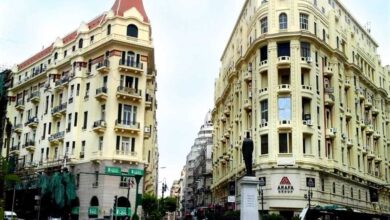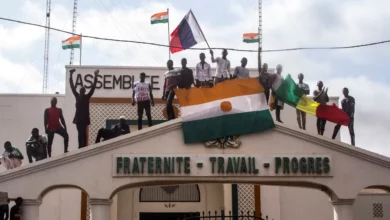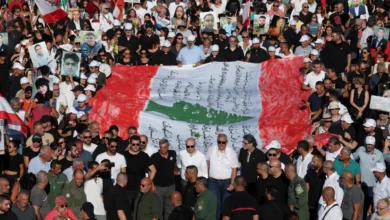
A procession of about 400, carrying black flags and chanting "Islamiya, Islamiya (Islamic, Islamic)" and "We will rule by the Quran" began exiting Tahrir on Friday evening. The group's numbers are growing as they proceed past Omar Makram Mosque.
Marches from different neighborhoods in Cairo converged in Tahrir Square on Friday with the arrival of protesters from Shubra, Sayeda Zeinab, Mohandiseen, Abbasseya and Giza.
Dozens of people who had marched from Suez Governorate also arrived in Tahrir on Friday afternoon. The activists began walking to Cairo on Wednesday.
Thousands of protesters have taken to Tahrir to participate in a demonstration demanding the cancellation of Article 28 of the Constitutional Declaration, which stipulates that the Presidential Elections Commission’s decisions cannot be challenged, protesting the interference of the military council in the constitutional drafting process, and rejecting the presidential candidacy of former regime figures.
Protesters marched from the Khazendar Mosque in the Shubra neighborhood in Cairo heading to Tahrir Square, chanting “Down with military rule.” April 6 Youth Movement activists were present at the mosque early in the morning to organize the march. They wore T-shirts bearing the phrase, “Down with military rule.”
Mostafa Mohamed, one of the march coordinators, told Al-Masry Al-Youm that members of Muslim Brotherhood and the Kefaya Movement participated in the march.
Marches to the square also departed from Istiqamah Mosque in Giza and Sayeda Zeinab Mosque in the Sayeda Zeinab neighborhood of Cairo. Cairo University students joined the march from Istiqamah Mosque. The marchers chanted anti-military council slogans.
Presidential candidate Khaled Ali joined a march that began at Mostafa Mahmoud Mosque in Mohandiseen, Cairo. Thousands participated in the march, according to state-run newspaper Al-Ahram.
Another march started at the Nour Mosque in Abbasseya, Cairo, also demanding the toppling of the military council, Al-Ahram reported. The march was led by the supporters of disqualified presidential hopeful Hazem Salah Abu Ismail and April 6 activists, with the participation of several revolutionary groups.
Dozens of lawyers joined protesters in Tahrir after a march started at the nearby Lawyers Syndicate headquarters. The protesting lawyers demanded the Constituent Assembly be formed from outside Parliament. They also chanted slogans calling on the Supreme Council of the Armed Forces to approve the amendments to the political rights law that would ban former regime figures from running in the presidential election.
While leading Friday prayer in Tahrir Square, Sheikh Mazhar Shahin, the imam of Omar Makram Mosque, urged all Egyptians to unite and agree on a single demand: rejecting the drafting of a new constitution under military rule.
Tens of thousands of protesters performed Friday prayers in Tahrir Square.
Shahin said that for Egypt’s sake, all political movements should unite behind one cause, adding that Friday’s protest represents a day of cohesion and aims to save the Egyptian revolution. He stressed that this Friday would be a milestone in Egypt’s history, and that Egypt will not fall.
"If those who ruled us before the 25 January revolution returned, they would not have mercy upon the people, and they would hang revolutionaries in Tahrir Square," he said.
Shahin chanted slogans including, “No constitution under military rule” and “Viva Egypt” many times during his sermon. Thousands of protesters echoed him.
After prayers were completed, protesters chanted, "The people want to execute the field marshal," "The people want to execute the president [Mubarak]," and "Leave, leave."
The April 6 Youth Movement and the Youth for Freedom and Justice Movement decided to dismantle their stages in the square after the number of stages increased to at least seven in the absence of coordination between groups participating in the protest.
Various political and activist movements had set up stages in the square, including the Muslim Brotherhood, the April 6 Youth Movement, and Abu Ismail supporters.
Mahmoud Afify, a spokesperson for the April 6 Youth Movement, told Al-Masry Al-Youm that the movement decided to take its stage for the sake of square unity.
Afify called on April 6 activists not to chant hostile slogans against any political movements present in the square, and not to get involved in any clashes. He also asked that protesters not approach the Interior Ministry or any police station.
The Youth for Freedom and Justice Movement said it decided to dismantle its stage due to confusing arising because of the large number of stages in the square.
Mohamed Abdallah, the April 6 Youth Movement’s head of mass citizen action, said there is an effort to unify the demands and slogans of the protest.
Popular committees tasked with securing Tahrir Square closed the entrance to the square at the Arab League headquarters and prevented cars from passing through the square from Qasr al-Nil Bridge. Street vendors have spread out through the square.
Protesters hung banners stating their demands, including "Together to protect the revolution…transferring power on 30 June," and "No to the 'remnants' [of the former regime]."
The Revolutionary Youth Parliament and the Second Revolution of Anger movement initially called for protests in the main squares of Cairo, Alexandria, Port Said and Minya to protest the presidential candidacies of former regime figures, most notably Omar Suleiman, who has since been disqualified.
The April 6 Youth Movement joined the call and asked that all Egyptians citizens, parties and groups take part in the demonstrations. Several political powers announced their intention to participate, including Islamist factions and liberal and secular forces.
April 6 said in a statement that the protest calls for the amendment of Article 28 of the Constitutional Declaration and the reformation of the Islamist-dominated Constituent Assembly.
The protest has been given several monikers, including, “No to writing the constitution under military rule,” "The revolution did not die,” and “Friday of protecting the revolution.”
Edited translation from Al-Masry Al-Youm




